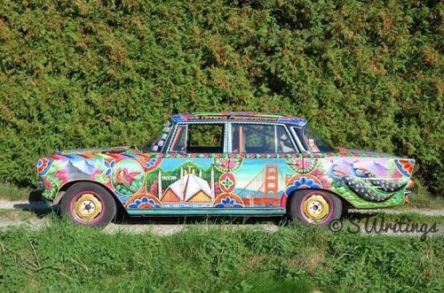
Photo credit: Carrettosiciliano
The local boy stammered. “Why are your wagons painted all those colors?”
Mar smiled. The adults stared but it was always the children who asked. “We paint the stories of our families and our taarn, the happy events and the sad. To keep track, until we get home.”
“And then what?”
Generations upon generations they had searched for Aarnanen. Mar did not expect to see it. Yet countless times she had sung the songs and imagined.
“We will break apart the wagons to build houses. Learn to farm. Take root.”
Somehow, to wander no more.
They would need new songs.
This is the first time I’ve brought the Yonlay into my stories. I’ll leave more description and explanation for other tales, but wanted to explain the title. “While we wander” is a ritual phrase for the Yonlay, one that they use to begin their stories and that is used in everyday talk to mean “our goddess guides us” much like contemporary people say “God be willing” or “God bless.”
Word count: 100. Submitted for this week’s Flash Fiction for Aspiring Writers challenge. Thanks to Priceless Joy, as always, for hosting! Click here to see the other stories. See the original photo prompt below.

Photo © S. Writings
I love their explanation as to why they paint their wagons! Wonderful story, Joy!
LikeLiked by 1 person
Thanks PJ, the photo really inspired me!
LikeLiked by 1 person
Very cool take. A harder prompt for you to do with a more archaic time period. The wagons describing these stories sound like they would be wonderful to see. But I can’t help thinking what a shame it us that all these stories disappear when they finally find home, take root.
LikeLiked by 1 person
Thanks! Yeah, I almost passed on the prompt this week because I couldn’t see how it could fit, and then BOOM, big inspiration.
In my original version, the plan was to destroy the wagons once they reached their promised land, to symbolize that they would no longer need to wander. But I thought it was too sad that way. If they use the painted wooden boards to build their houses instead, they can still see the stories!
LikeLiked by 1 person
That’s a good point 🙂
LikeLiked by 1 person
What a clever way to keep a record of events. Every picture on that wagon must trigger memories that would otherwise become dead an buried. Does this mean that Mar’s people do not write, or do they simply find this pictorial method of recording events preferable? Sorry for asking – I just wondered .
LikeLiked by 1 person
Hm, very interesting question, Millie, I hadn’t thought about that yet. The Yonlay are nomadic, but that wouldn’t stop them from schooling their children, if they had good reason to read and write. I would say that at least some of them know how to read and write, to keep the records of their taarn and where they have been so far, and possibly to leave messages for other taarn whose paths they may cross. I was thinking of the events they’re painting on the wagons as being personal stories, like a diary of the family, which most people at this tech level wouldn’t write down anywhere anyway, even if they write for other reasons. So the wagon is less a replacement for a book, and more a replacement (or addendum) to the stories your dad tells to everyone he meets about what happened on his last vacation or that lucky escape you had when you did something stupid as a kid.
LikeLiked by 1 person
Well, painting the wagons is a great idea, and it fits well in your story. I just wondered about the writing. Thanks for explaining.
LikeLiked by 1 person
‘The adults stared but it was always the children who asked. ‘ … Great line pointing to an apt distinction between adults and children! Nice take! 🙂
LikeLiked by 1 person
Thanks! I especially liked that line too. 🙂
LikeLiked by 1 person
I love the idea of wagons painted with all their stories. Hopefully their wandering won’t continue for too much longer. A very enjoyable story, Joy. 🙂
LikeLiked by 2 people
Thanks Lou — I haven’t figure out for myself yet when (if ever) they find Aarnanen. I do know that a large contingent of them settled in Shadowbosk, although those who still wander consider them to have given up and abandoned the faith.
LikeLiked by 1 person
I never cease to be amazed by how you incorporate all these stories in one fictional world. And such gorgeous art!
LikeLiked by 1 person
Thank you so much! I really loved the photo of the Sicilian cart too.
LikeLiked by 1 person
That photo definitely caught my eye!
BTW, thank you for the follow 🙂
LikeLiked by 1 person
You explanation makes it all the more fascinating.
LikeLiked by 1 person
Thank you, Jacqueline! There is always so much more I want to squeeze in, to tell about the various people I’m writing about. I’m glad my little extra bits are appreciated. 🙂
LikeLiked by 1 person